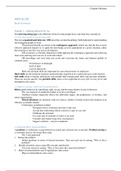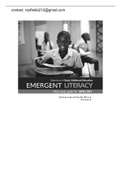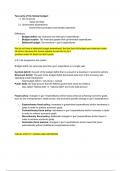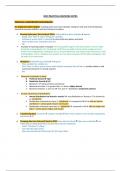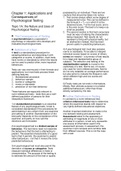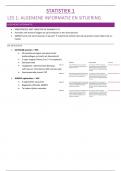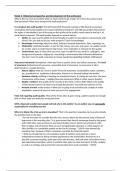HRM & OB
Book Summary
Chapter 1 – Making OB work for me
The knowing-doing gap is the difference between what people know and what they actually do.
1.1 The value of OB to my job and career
The term organizational behavior (OB) describes an interdisciplinary field dedicated to understanding
and managing people at work.
The practical benefits are based on the contingency approach, which says that the best or most
effective approach requires us to apply the knowledge an tools appropriate to a given situation, rather
than relying on one best way across all situation.
Self-awareness is critically important to both applying the contingency approach and achieving
short-term and long-term success at work and school.
OB knowledge and tools help you avoid and overcome the limits and inherent pitfalls of
common sense:
Overreliance on hindsight
Lack of rigor
Lack of objectivity
Both soft and hard skills are important for your attractiveness to employers.
Hard skills are the technical expertise and knowledge required to do a particular task or job function.
Soft skills relate to human interactions and include both interpersonal skills and personal attributes.
These are not job specific, but portable skills, more or less important in every job, at every level, and
throughout your career.
1.2 Right vs. wrong – ethics and my performance
Ethics guides behavior by identifying right, wrong, and the many shades of gray in between.
The vast majority of unethical conduct at work is not illegal.
Unethical conduct negatively affects the individual targets, the perpetrators, co-workers, and
entire organizations.
Ethical dilemmas are situations with two choices, neither of which resolves the situation in an
ethically acceptable manner.
Confronting (un)ethical conduct:
Recognize that it’s business and treat it that way
Accept that confronting ethical concerns is part of your job
Challenge the rationale
Use your lack of seniority or status as an asset
Consider and explain long-term consequences
Suggest solutions – not just complaints
1.3 Applying OB to solving problems
A problem is a difference or gap between an actual and a desired stat or outcome. Problem solving is
a systematic process for losing these gaps.
The 3-step approach:
1. Define the problem
Define problems in terms of desired outcomes. Then test each one by asking, “Why is this a
problem?’
2. Identify potential causes using OB concepts and theories
Test your causes by asking, “Why or how does this cause the problem?”
3. Make recommendations and (if appropriate) take action
Map recommendations onto causes
, Claudine Mollema
1.4 Structure and rigor in solving problems
The person-situation distinction is a fundamental way to organize, understand, and apply OB concepts.
Person factors are the infinite characteristics that give individuals their unique identities.
Situation factors are all the elements outside ourselves that influence what we do, the way we
do it, and the ultimate results of our actions.
The interactional perspective states that behaviour is a function of interdependent person and
situation factors.
Workplace behavior occurs at three levels – individual, group/team, and organizational.
1.5 The organizing framework for understanding and applying OB
The organizational framework is a tool that helps you to organize, understand, and apply your
knowledge to solve problems:
The systems approach – inputs, processes, outcomes – is the basis of the Organizing Framework.
Applied approaches to selecting a solution:
Resolving means choosing a satisfactory solution, one that works but is less than ideal.
Solving problems is the optimal or ideal response.
Dissolving problems requires changing or eliminating the situation in which the problem occurs.
Basic elements for selecting an effective solution:
Selection criteria
Consequences
Choice process
1.6 Preview and application of what I will learn
-
Chapter 2 – Individual differences and emotions
Tips for an interview:
1. Know what you want 4. Know what is expected of you
2. Look for good and bad 5. Ask where others have gone
3. Think of the job and the manager separately 6. Meet people like you
2.1 The differences matter
Individual differences (IDs) are the many attributes, such as traits and behaviors, that describe each of
us as a person. There is a distinction between relatively fixed and flexible IDs:
, Claudine Mollema
2.2 Intelligences: there is more to the story than IQ
Intelligence represents an individual’s capacity for constructive thinking, reasoning, and problem
solving.
Howard Gardner describes in his theory of intelligences, eight different intelligences –
linguistic, logical(-mathematic), musical, (bodily-)kinaesthetic, spatial, interpersonal, intrapersonal, and
naturalist.
Practical intelligence is the ability to solve everyday problems by utilizing knowledge gained
from experience in order to purposefully adapt to, shape, and select environments. One uses these skills
to a) manage oneself, b) manage others, and c) manage tasks.
2.3 Personality, OB, and my effectiveness
Personality is the combination of stable physical, behavioural, and mental characteristics that gives
individuals their unique identities.
A useful way to describe personality is using the Big Five personality profiles:
The dimensions are extroversion (outgoing, talkactive, sociable, assertive), agreeableness ( trusting,
good-natured, cooperated, soft-hearted), conscientiousness (dependable, responsible, achievement-
oriented, persistent), emotional stability (relaxed, secure, unworried), and openness to experience
(intellectual, imaginative, curious, broad-minded).
A proactive personality is an attribute of someone relatively unconstrained by situational
factors and who effect environmental change. Proactive people identify opportunities and act on them,
show initiative, take action, and persevere until meaningful change occurs.
Employers use personality tests to select and place employees. There is no ideal personality,
however, and personality testing often has flaws.
2.4 Core self-evaluations: how my efficacy, esteem, locus, and stability affect my performance
Core self-evaluations (CSEs) represent a broad personality trait made up of four narrow and positive
individual traits:
1. Generalized self-efficacy
Self-efficacy is a person’s belief about his or her chances of successfully accomplishing a
specific task – can be improved via experience, behavior models, persuasion from others, and
emotional state.
2. Self-esteem
Self-esteem is your general belief about your own self-worth.
3. Locus of control
Locus of control is a relatively stable personality characteristic that describes how much
personal responsibility we take for our behavior and its consequences.
Internal: people who believe they control the events and consequences that affect their lives.
External: people who believe their performance is the product of circumstances beyond their
immediate control.
4. Emotional stability
Individuals with high levels of emotional stability tend to be relaxed, secure, unworried, and
less likely to experience negative emotions under pressure.
Managers can realize the practical value of CSEs by selecting employees based on them and then
training them to enhance elements of their CSEs.
2.5 The value of being emotionally intelligent
Emotional intelligence (EI) is the ability to monitor your own emotions and those of others, to
discriminate among them, and to use information to guide your thinking and actions – four components:
1. Self-awareness
2. Self-management
3. Social awareness
4. Relationship management
, Claudine Mollema
EI is associate with higher sales and improved retention, as well as leadership emergence, behavior, and
effectiveness. An individual can develop EI by building personal competence (social awareness and
relationship management).
2.6 Understand emotions to influence performance
Emotions are complex, relatively brief responses aimed at a particular target, such as a person,
information, experience, or event. They also change psychological and/or physiological states.
Most experiences at and outside work are a mixture of positive and negative emotions, rather
than purely one or the other. Besides positive and negative, we distinguish emotions in terms of whether
they have a future orientation (anxiety) or a past orientation (anger).
Organizations have emotion display norms, or rules that dictate which types of emotions are
expected and appropriate for their members to show. It is important to learn how to recognize and
manage emotions.
Chapter 3 – Social perception and managing diversity
3.1 Person perception
Perception is a cognitive process that enables us to interpret and understand our surroundings.
Person perception is influenced by three components: characteristics of the perceiver,
characteristics of the target, and characteristics of the situation.
Person perception affects the wide variety of organizational activities including hiring decisions,
performance appraisals, and leadership.
Implicit cognition represents any thoughts or beliefs that are automatically activated from
memory without our conscious awareness.


